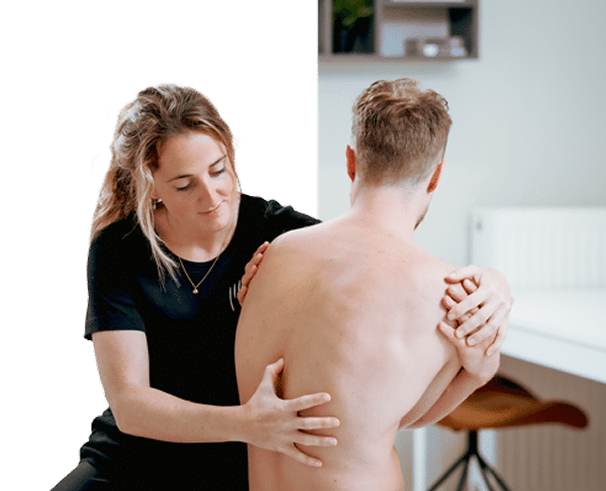Help, I have pain in my Achilles tendon!
Achilles tendon pain can be an annoying killjoy for both athletes and people who simply want to stay active. The Achilles tendon, which runs from the calf to the heel, plays a crucial role in everyday movements such as walking, running and jumping. When this tendon is overused or damaged, it can lead to pain and mobility problems.
In brief
- What is it? An Achilles tendon injury is an overuse or tear in the Achilles tendon that causes pain and stiffness at the back of the ankle.
- Symptoms: Pain, swelling and tenderness at the bottom of the leg, especially when walking or playing sports.
- Causes: Usually caused by overexertion during sports, sudden movements or insufficient warm-up.
- Treatment: Rest, physical therapy, stretching exercises, and sometimes anti-inflammatory medication. Surgery may be required in severe cases.
- Recovery time: Depending on severity, recovery can range from several weeks to months.

At The Physio Man, we understand how important it is to recover quickly and effectively from this pain and prevent new injuries. In this article, you’ll read all about the causes, symptoms and treatment options for Achilles tendon injuries so you can be well-informed and prepared for your recovery.
What is an Achilles tendon injury?
The Achilles tendon is the largest and strongest tendon in our body, connecting the calf muscles to the heel bone. When this tendon becomes overloaded due to repetitive or overly intense movements, small tears or swelling can develop in the tissue resulting in annoying pain. This injury is often associated with sports activities such as running, jumping and other explosive movements, but can also occur in everyday activities. The injury is common in people between the ages of 30 and 60 and can affect both athletes and non-athletes.
Causes of an Achilles tendon injury
Achilles tendon injuries often result from overuse or too rapid an increase in load on the tendon such as explosive movements. Below is an overview of some of the major causes:
- Intense sports activities: Activities such as running, jumping, and sprinting can put heavy strain on the Achilles tendon, especially when performed without an adequate warm-up.
- Change in surfaces: Changing from hard to soft surfaces (or vice versa) can put extra pressure on the tendon, as the body must quickly adapt to the new load.
- Poor running technique: Improper running posture can lead to unnatural strain on the Achilles tendon, increasing the risk of overuse.
- Insufficient recovery time: When the tendon is not given enough time to recover between efforts, small tears can develop over time.
- Poor footwear: Shoes that do not provide adequate heel or arch support can increase the strain on the Achilles tendon. This is especially true of shoes without cushioning or with soles that are too floppy.
- Biomechanical abnormalities: Abnormalities such as overpronation (tilting the foot too far inward) or leg length differences can put extra stress on the tendon, which can lead to long-term injuries.
Symptoms of an Achilles tendon injury
Achilles tendon injuries can vary in severity, but the most common symptoms are:
- Pain at the back of your ankle: You often feel pain a few inches above the heel, especially during or after activities.
- Stiffness in the morning: The tendon often feels stiff when getting up, and this stiffness usually subsides after moving around for some time.
- Swelling and redness: With more severe overuse, the tendon may swell and sometimes turn red.
- Movement restriction: It may be difficult to fully flex or extend the foot, affecting daily movements.

Self-care options for an injury or pain
It is important to take good care of your Achilles tendon, especially in the early stages of an injury. Here are some ways you can begin self-care at home:
- Use of Ice: Apply ice to the sore every two hours for the first 48 hours. Always put a thin cloth between the ice and the skin to prevent frostbite. This helps to reduce inflammation and pain. Also check out the ICE method.
- Self-massage: Gently massage the calf muscles to relieve tension in the tendon. Using your fingers or a massager, gently work toward the Achilles tendon.
- Stretching Exercises for Calf Muscles: Stand with your hands against a wall, put one foot forward and keep the other stretched back. Keep the heel of the back leg on the ground and feel a slight stretch in the calf. Hold this for 15-30 seconds and then switch legs.
- Supportive Footwear: Wear shoes with good cushioning and heel support. This can reduce the strain on your Achilles tendon.
By applying these self-care options, you can support the recovery process of an Achilles tendon injury and prevent aggravation. For long-term or severe symptoms, we recommend contacting a physical therapist.
Tips to prevent an Achilles tendon injury
Preventing an Achilles tendon injury starts with proper preparation and body care. Here are some preventive tips:
- Eccentric Strength Exercises: Exercises such as the Nordic curl help to strengthen the tendon and protect it from strain. Eccentric exercises cause the muscle to lengthen in a controlled manner, making the tendon stronger.
- Build up slowly: Avoid large changes in load, especially when building up a training schedule. Start slowly and gradually increase intensity.
- Warm-up and Cooling-down: Prepare your muscles for exertion and allow them to cool down gently afterward.
- Proper Footwear and Surface: Make sure you have well-supporting shoes and avoid overly hard surfaces if you do a lot of running or sports.
- Listening to Your Body: Keep a close eye on how your tendon responds to strain. If there is pain or stiffness, it is important to adjust the intensity of activities.

Frequently asked questions (FAQ) about Achilles tendon pain and injuries
- Is rest enough to heal an Achilles tendon injury or the pain?
-
- Rest can help temporarily relieve pain, but complete healing often requires a combination of rest, exercise and physical therapy. Active treatment, such as muscle-strengthening exercises and mobility training, significantly increases the likelihood of a good recovery.
- Does an injection help Achilles tendon pain?
-
- Corticosteroid injections can provide short-term relief in some cases, but have an increased risk of a complete tear of the tendon in the long term. Therefore, these injections are often not recommended for Achilles tendon injuries.
- How long does recovery from an Achilles tendon injury take?
-
- Recovery varies depending on the severity of the injury. For mild symptoms, recovery may take several weeks, but for moderate to severe injuries, it may be months. Some chronic injuries require long-term rehabilitation.
- Can I keep playing sports with a mild Achilles tendon injury?
-
- Light activities can sometimes be continued as long as the pain remains minimal and does not worsen. However, it is important to avoid intense strain and adjust activities based on the symptoms.
- Which exercises are most effective for recovery?
-
- Eccentric exercises, such as the Nordic curl and controlled calf exercises, are particularly effective for strengthening the Achilles tendon and promoting recovery. Physical therapists can help you perform these exercises.
Achilles tendon injury physical therapy at The Physio Man: For a personalized recovery plan
At The Physio Man, we understand that an Achilles tendon injury can significantly affect your daily life and sports activities. Our physical therapists are here to guide you through your recovery with personalized attention and effective treatments. We provide the specific support and knowledge to not only recover, but come back stronger. Make an appointment today and find out how we can help you recover optimally and reduce future injury risk.
Are you dealing with an Achilles tendon injury or pain in your heel? If the pain persists, don’t hesitate to make an appointment at De Fysio Man in Amsterdam. Our physiotherapists are here for you. Let’s work together towards a pain-free and healthier life! View all our physiotherapies here, or make an appointment right away.
Why choose The Physio Man?
- Latest treatment techniques
- We look at the body as a whole
- 80% of our patients are complaint-free within a few treatments
- No long waiting lists
- Also open in the evening
At The Physio Man, we offer a wide range of treatment options aimed at reducing symptoms and improving quality of life. For questions or an intake consultation, contact us. Email info@defysioman.nl or call 020-3542926. Prefer to come by? Visit us at Jan van Galenstraat 301 in Amsterdam.


